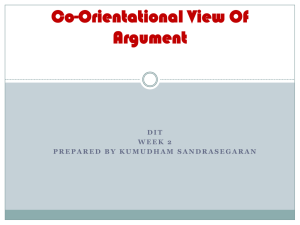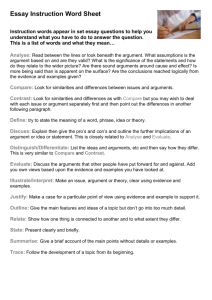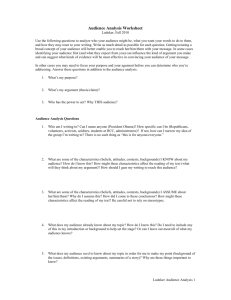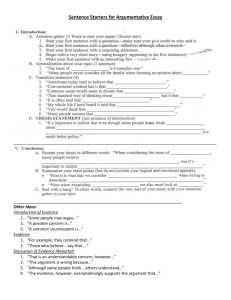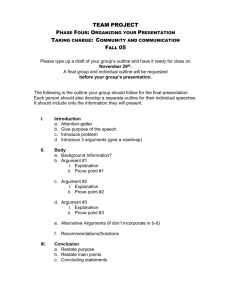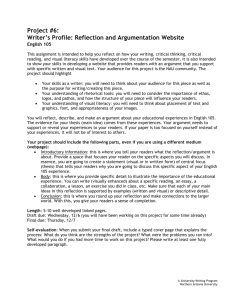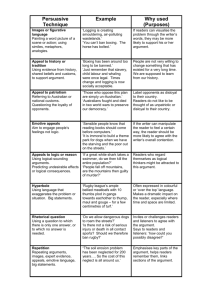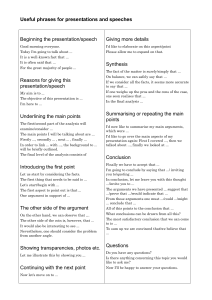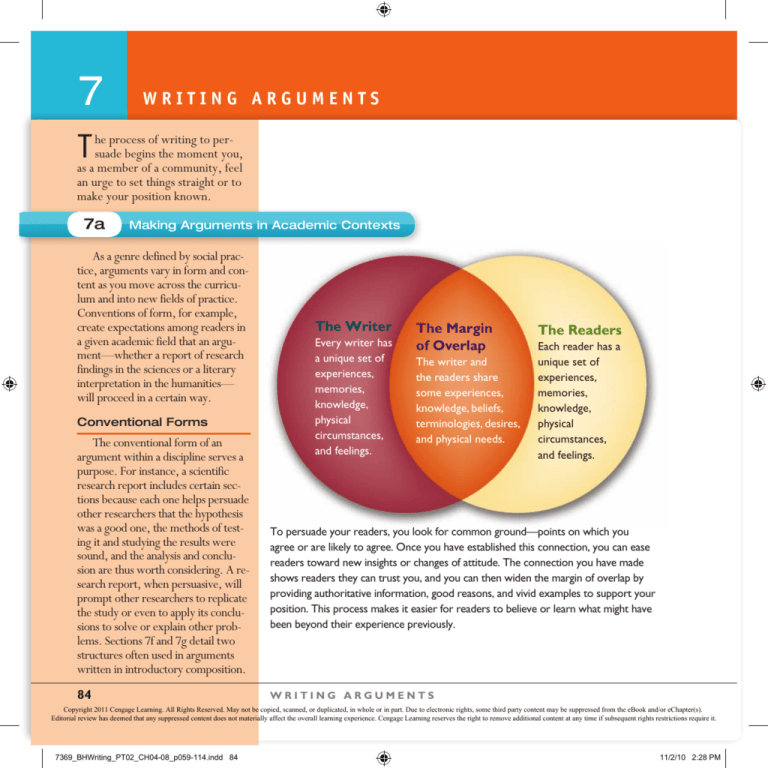
7
WRITING ARGUMENTS
T
he process of writing to persuade begins the moment you,
as a member of a community, feel
an urge to set things straight or to
make your position known.
7a
Making Arguments in Academic Contexts
As a genre defined by social practice, arguments vary in form and content as you move across the curriculum and into new fields of practice.
Conventions of form, for example,
create expectations among readers in
a given academic field that an argument—whether a report of research
findings in the sciences or a literary
interpretation in the humanities—
will proceed in a certain way.
Conventional Forms
The conventional form of an
argument within a discipline serves a
purpose. For instance, a scientific
research report includes certain sections because each one helps persuade
other researchers that the hypothesis
was a good one, the methods of testing it and studying the results were
sound, and the analysis and conclusion are thus worth considering. A research report, when persuasive, will
prompt other researchers to replicate
the study or even to apply its conclusions to solve or explain other problems. Sections 7f and 7g detail two
structures often used in arguments
written in introductory composition.
84
The Writer
Every writer has
a unique set of
experiences,
memories,
knowledge,
physical
circumstances,
and feelings.
The Margin
of Overlap
The writer and
the readers share
some experiences,
knowledge, beliefs,
terminologies, desires,
and physical needs.
The Readers
Each reader has a
unique set of
experiences,
memories,
knowledge,
physical
circumstances,
and feelings.
To persuade your readers, you look for common ground—points on which you
agree or are likely to agree. Once you have established this connection, you can ease
readers toward new insights or changes of attitude. The connection you have made
shows readers they can trust you, and you can then widen the margin of overlap by
providing authoritative information, good reasons, and vivid examples to support your
position. This process makes it easier for readers to believe or learn what might have
been beyond their experience previously.
WRITING ARGUMENTS
Copyright 2011 Cengage Learning. All Rights Reserved. May not be copied, scanned, or duplicated, in whole or in part. Due to electronic rights, some third party content may be suppressed from the eBook and/or eChapter(s).
Editorial review has deemed that any suppressed content does not materially affect the overall learning experience. Cengage Learning reserves the right to remove additional content at any time if subsequent rights restrictions require it.
7369_BHWriting_PT02_CH04-08_p059-114.indd 84
11/2/10 2:28 PM
7a
Identifying Common Ground with Readers
Claim and Support
What does your audience care about? See whether you can find a way to link your
concerns, which they may not have thought about yet, to their existing concerns.
In the academic community, a
successful argument includes a claim
about a contested issue and support
for the claim in the form of good reasons, examples, expert knowledge,
and verbal and visual evidence. A
claim is a position the writer stakes
out in the thesis statement. Most
issues that are considered worth
writing arguments about are disputed; reasonable people disagree
about them. When planning an argument, consider the many sides of a
contested issue and then make smart
and ethical decisions about what
claims to put forth, how to support
them, and how to persuade others
that your point of view is warranted
and desirable.
I want to show my friends that
volunteering for U.S. Public Interest Research
Group (U.S. PIRG) is worthwhile, but they
only seem to be interested in getting their
careers started.
So how will volunteering help them in their careers?
They might . . .
— develop research and presentation skills
that they will be able to use on their jobs.
— be able to promote themselves as people
who follow through to reach important goals.
— show potential employers they are willing to
contribute toward the common good.
Maybe I should argue that they should each choose
an organization to volunteer for, not just promote
PIRG. Since my friends are going to be searching for
different types of jobs, I’ll bet they can each find an
organization particularly suited to their interests.
Choosing a Topic
7b
© Francesco Ridolfi/iStockphoto.com
A good topic for an argument in a
composition class has these important
attributes:
■ It is a contested issue. Reasonable people hold substantially
different opinions about it.
■ It is an issue you care about,
feel invested in, or find intellectually stimulating.
■ It is limited enough in terms of
the amount of research you’ll
need to do and the number of
pages it will take to cover the
topic adequately.
CHOOSING A TOPIC
85
Copyright 2011 Cengage Learning. All Rights Reserved. May not be copied, scanned, or duplicated, in whole or in part. Due to electronic rights, some third party content may be suppressed from the eBook and/or eChapter(s).
Editorial review has deemed that any suppressed content does not materially affect the overall learning experience. Cengage Learning reserves the right to remove additional content at any time if subsequent rights restrictions require it.
7369_BHWriting_PT02_CH04-08_p059-114.indd 85
11/2/10 2:28 PM
7c
Developing a Working Thesis
The thesis statement in an argument is composed of (1) the topic
and (2) your claim about the topic.
The claim is the assertion that your
paper will support with reasons and
evidence. It’s the opinion you develop about the topic as you think
and conduct research.
As you start your project, developing a working thesis statement will
help you learn more about your rhetorical situation and your topic. For
instance, you might think, “Anger
management classes should be required for people who display road
rage.” This idea is your working thesis. As you research the problem of
road rage and some of the solutions
that have been proposed, you may
discover that several states already
have anger management programs in
place. In other states, community
service is seen as a more effective
way to treat those guilty of the
crime. You may decide that community service shouldn’t be associated
with punishment. You decide that
you will argue against community
service as a “penalty” handed out by
courts for a wide variety of minor offenses. You realize, however, that
you will need to propose a way to
encourage community service with a
positive attitude—perhaps by letting
road rage perpetrators choose among
alternatives.
Conventional Forms for Argument Claims
86
WRITING ARGUMENTS
Basic Form
Topic
Examples
Claim
Something should (or shouldn’t)
be done.
Toxic waste disposal needs to be
reconsidered because containers have a
finite lifetime.
Something is good (or bad).
Hackers who expose security flaws in
popular software protect consumers.
Something is true (or false).
Contrary to urban legend, alligators do
not roam the New York City sewers.
Project Checklist
Do You Have an Effective Working Thesis Statement?
❏ Does it indicate that the issue is contestable? Consider which people or
groups of people would not agree with your working thesis. Write down
their objections. If you find at least a couple of substantial objections,
the issue is contestable.
❏ Does it give a sharp focus to the topic? Does it provide a specific claim
and possible reasons and evidence that support that claim?
❏ Does it have the potential to change as new information comes to light
through research? If you can think of how and why it might change,
then your thesis can be deliberated and debated.
❏ Does it help you map out the structure of your argument?
❏ Does it invite more information? Can you clearly see what you would
need to include in order for it to be believable?
Copyright 2011 Cengage Learning. All Rights Reserved. May not be copied, scanned, or duplicated, in whole or in part. Due to electronic rights, some third party content may be suppressed from the eBook and/or eChapter(s).
Editorial review has deemed that any suppressed content does not materially affect the overall learning experience. Cengage Learning reserves the right to remove additional content at any time if subsequent rights restrictions require it.
7369_BHWriting_PT02_CH04-08_p059-114.indd 86
11/2/10 2:28 PM
Understanding Multiple Viewpoints
Identifying Other Perspectives
Think about your working thesis statement. Who would agree with it, who might
agree with it, and who would disagree with it? Why? Divide the possible perspectives into at least two, and preferably more than two, camps. Set up a chart like
the one below to help you keep track of them.
People who agree
would think . . .
People who might agree
would think . . .
People who disagree
would think . . .
Then, using a key term on your topic, conduct an Internet search to find
newspaper or online news source editorials that illustrate these positions. For
example, if you wanted to survey the range of opinion on augmented reality, you
could try these steps:
1. Go to Google News: http://news.google.com.
2. Type “augmented reality” (in quotation marks) in the search box at the top of
the page, and then click on Search News. Your search results will include a
long list of editorials on this topic from various news sources around the
world. You can tell from the title of the page and the brief summary whether
it’s directly related to your topic. Even the first few search results for “augmented reality” reveal a broad range of opinion, with headlines like “Cyborg
Anthropologist,” “Augmented Reality Becomes a Reality,” and “Augmented
Reality: Your World, Enhanced.”
3. Add to your chart a summary of each position or each editorial that looks
helpful. (Be sure to include the citation information.)
4. Analyze an editorial on your topic from each camp, focusing on questions like
these:
■
■
■
■
■
What position does the editorial take?
What evidence or reasons does the editorial provide?
What is at stake in the argument?
Does the editorial address the views of the other side?
What doesn’t the editorial say that it might have said in the interest of arguing
its position more effectively?
UNDERSTANDING MULTIPLE VIEWPOINTS
7d
To write an effective argument
designed to persuade, you need to
develop a keen understanding of the
beliefs of the people opposed to your
position, what arguments they make
to one another, and which arguments
on the other side (your side) they distrust. Consider that there may be
moderate positions somewhere in the
middle.
For example, suppose you believe
that the death penalty is cruel and unusual punishment under any circumstances. If you want to persuade
death penalty advocates of your point
of view, research their views. Visit
the Weekly Standard (http://www
.weeklystandard.com), the conservative, pro–death penalty journal, even
if you prefer the position of the New
Republic (http://www.tnr.com). See
whether you can identify positions
that have qualifications. Research the
positions of people who believe there
should be a moratorium while we
learn more about the issues, such
as the North Carolina Coalition for
a Moratorium (http://www
.ncmoratorium.org). Some people
hold other views—for example, that
the death penalty should not apply to
juveniles or should be used only under extraordinary circumstances.
Your best writing may emerge from
using the evidence that others would
use against you.
87
Copyright 2011 Cengage Learning. All Rights Reserved. May not be copied, scanned, or duplicated, in whole or in part. Due to electronic rights, some third party content may be suppressed from the eBook and/or eChapter(s).
Editorial review has deemed that any suppressed content does not materially affect the overall learning experience. Cengage Learning reserves the right to remove additional content at any time if subsequent rights restrictions require it.
7369_BHWriting_PT02_CH04-08_p059-114.indd 87
11/2/10 2:28 PM
Considering Your Audience and Aims
Writing arguments involves developing, shaping, and presenting
content to an audience for a
reason.
■ Developing: When you develop
an argument, you take your
subject matter into account in
great detail through a process
of invention and inquiry.
■ Shaping: When you shape an argument, you consider audience
and purpose to decide how
much of that content is relevant
or useful.
■ Presenting: When you present
an argument, you consider how
your content should be arranged
and what style, diction, and
tone best convey it to readers.
Effective writers shape and refine subject matter to suit circumstances, which include the opinions
and attitudes of the audience and
the purpose for writing. Your consideration of what your readers already know about the subject, how
they feel about it, and what contrary opinions they hold toward it
should guide every decision you
make as you shape and present
your argument. The aim of your
argument—to change minds, rally
supporters, foster sympathy, and
so on—should likewise guide your
selection, shaping, and presentation of subject matter.
A Comparison of the Audiences and Aims of Argument
88
WRITING ARGUMENTS
People who hold views
different from yours
People who share
your view
To persuade people to
change an attitude or
behavior. Changing
someone’s attitude is
possible only when
knowledge is uncertain
and there are multiple
perspectives.
To reinforce shared
convictions. When people
already agree, the purpose
of argument may be to
turn that agreement into
action—for example,
working to support a
cause. In college classes,
you typically won’t argue
issues on which your
readers already agree.
Instead, find the basis for
disagreement on a subject,
and build an argument
from there.
To inquire into the shades
of meaning in a subject
so that you can open
it up to reflection and
reconsideration. Help
your audience understand
that the subject is more
People who wish to under- complex than they had
stand multiple views
imagined.
Writer’s Specific
Purpose
■
■
■
■
■
■
■
■
■
■
■
To change people’s
minds and attitudes
To solve problems
To resolve conflict
To build consensus
To create
community
To reinforce belief
To move people
toward
commitment
and action
To foster
identification
To open up a topic
for discussion,
debate, and further
inquiry
To question
common knowledge
To stimulate further
research
© Amanda Rohde/iStockphoto.com
Writer’s General
Purpose
© CREATISTA/Shutterstock.com
Audience
Daniel Korzeniewski/Shutterstock.com
7e
Copyright 2011 Cengage Learning. All Rights Reserved. May not be copied, scanned, or duplicated, in whole or in part. Due to electronic rights, some third party content may be suppressed from the eBook and/or eChapter(s).
Editorial review has deemed that any suppressed content does not materially affect the overall learning experience. Cengage Learning reserves the right to remove additional content at any time if subsequent rights restrictions require it.
7369_BHWriting_PT02_CH04-08_p059-114.indd 88
11/2/10 2:28 PM
Arguing to Inquire: Rogerian Argument
Perspectives
Most topics for argument
naturally lend themselves to
alternative points of view.
The Margin of Overlap
Each perspective shares some
common premises with the others.
Rogerian Argument
The aim is to broaden the
margin of overlap among
positions by fairly representing
multiple sides of an issue,
creating the opportunity for
finding common ground.
Rogerian argument acknowledges and accommodates alternative positions and
perspectives. The purpose is not so much to settle an issue as to map the various
positions that reasonable people might hold. Throughout a Rogerian argument,
the writer emphasizes common ground, attempts to be objective and truthful
about the alternative perspectives, and concedes the relevance of other points of
view. The argument often provides background or context, in the hope that
enlarging the frame of the argument will make it easier for the various disputants
to find common ground. Rogerian argument is particularly useful when your
audience is hostile.
ARGUING TO INQUIRE: ROGERIAN ARGUMENT
7f
Often an either/or argument
not only presumes an issue has only
two sides but also shows the
amount of force holding people
apart in the world. Sometimes people in ongoing debates and arguments become so defensive that
they cannot even see the humanity
of the people with whom they are
arguing.
Arguing to inquire involves arguing ethically and intelligently in
order to build grounds for consensus. One form of arguing to inquire
is Rogerian argument, a method
developed by psychologist Carl
Rogers (1902–1987). The goal of
Rogerian argument is to find as
much common ground as possible
so that parties in the debate or argument will see many aspects of
the issue similarly. Believing that
shared views of the world create
more harmonious conditions,
Rogers hoped that people would
hold enough in common that they
could be persuaded, through debate and dialogue, to allow differences to coexist peacefully.
Rogerian argument seeks to resolve
conflict by expanding the margin of
overlap between people.
89
Copyright 2011 Cengage Learning. All Rights Reserved. May not be copied, scanned, or duplicated, in whole or in part. Due to electronic rights, some third party content may be suppressed from the eBook and/or eChapter(s).
Editorial review has deemed that any suppressed content does not materially affect the overall learning experience. Cengage Learning reserves the right to remove additional content at any time if subsequent rights restrictions require it.
7369_BHWriting_PT02_CH04-08_p059-114.indd 89
11/2/10 2:28 PM
7g
Arguing to Persuade: The Classical Form
Aristotle described rhetoric as
the art of finding the available means
of persuasion in any particular case.
This means, simply, that a speaker
or writer needs to know what arguments to use and the best way to
present them. Aristotle spent most
of his time trying to identify how to
invent arguments and how to determine their potential usefulness.
Cicero, a Latin rhetorician, later described a generic form for the classical argument.
The classical form rests on the
theory that we change our minds
and come to believe in something
new in a predictable pattern. First
something needs to capture our attention. Then we need to learn
more about it, analyze it, consider
what others say about it, and
interpret it.
The Classical Form of Argument
■
■
■
■
■
■
90
Introduction. The introduction puts the reader in the right frame of mind and
suggests, “Here comes something important.” It might tell a story that illustrates
the controversy or the need to resolve it.
Narration. The narration provides background information necessary for understanding the issue or tells a story that makes a comparison, discredits opponents’ views, or just entertains the audience. It often includes cited research
and references to what other people have said about the topic in the past.
Partition. The partition lists the points to be proven or divides the points into
those agreed on and those in dispute. It is usually very brief, sometimes only a
few sentences if the essay is short.
Confirmation. The confirmation is the proof and thus argues the case, thesis,
or main point of contention. It may include evidence, examples, and quotations
from authoritative sources. Each premise or assumption may be unpacked, explained, and argued using deductive reasoning (arguing from accepted fact to
implications) or inductive reasoning (arguing from examples). The confirmation
takes up each of the points listed in the partition or implied in the thesis or
controlling idea.
Refutation. The refutation takes the other side or sides and shows why they
don’t hold. It may dispute the positions of opponents, using anticipated or actual arguments; cite claims of inadmissible premises, unwarranted conclusions,
or invalid forms of argument; or cite stronger arguments that nevertheless apply only in unrealistic circumstances. The refutation should address the most
likely counterarguments, treating them fairly and accurately so as not to arouse
the indignation of the audience.
Conclusion. The conclusion sums up or enumerates the points of the argument; it may appeal to the emotions of the readers, encouraging them to feel
motivated to change attitudes and sometimes to feel resentful of opposing
viewpoints or sympathetic to the writer’s position. The conclusion should help
people understand the significance of the issue and the importance of viewing it
as the writer proposes. The conclusion may also rouse the audience to action
or make a specific recommendation.
WRITING ARGUMENTS
Copyright 2011 Cengage Learning. All Rights Reserved. May not be copied, scanned, or duplicated, in whole or in part. Due to electronic rights, some third party content may be suppressed from the eBook and/or eChapter(s).
Editorial review has deemed that any suppressed content does not materially affect the overall learning experience. Cengage Learning reserves the right to remove additional content at any time if subsequent rights restrictions require it.
7369_BHWriting_PT02_CH04-08_p059-114.indd 90
11/2/10 2:28 PM
Supporting Your Claim
Project Checklist
Motivating Your Readers
7h
An effective argument includes
reasons and evidence in support of
the points you are asking readers to
accept. Organized logically and
presented persuasively, the reasons
and evidence you provide make
your case.
How can you motivate your readers to identify with your position and
change their actions or attitudes?
Research Your Topic
❏ Consider the kinds of evidence that your audience will find
persuasive. Suppose you are against hunting animals for sport.
Claiming that all animals should have the same rights as humans might
not be persuasive with hunters, who might see their rights under the
Constitution as superseding those of animals. Rather, you might suggest
alternative sports that provide the same kind of satisfaction as hunting
or demonstrate that, because of accidents and hunter-on-hunter
violence, hunting is more dangerous to humans than to animals. You
will need to include evidence that helps hunters see that it is in their
best interest to try something else.
❏ Treat your readers as intelligent and reasonable people, even if you
think their positions are wrong. Suppose you want to advance the
cause of Students Against Drunk Driving. Saying that social drinkers are
“incapable of knowing what is best for them” or calling them “future
alcoholics” is likely to cause them to ignore the logic of your appeal.
❏ Tell readers why they should consider your position, and be direct
about what you want them to do or think. What difference does it
make if readers agree with you? What exactly should they take away
from your argument? What do you want readers to do? How should they
see the subject differently now?
❏ Make the case for why the issue is important now. Readers will want
to feel some urgency. What difference does it make if they believe you
now rather than later (or never)? What will happen if the situation is
not resolved?
Find the background information
and facts you can share with readers
so that they will judge your argument
as reasonable. It’s smart to know
more about your subject matter than
your audience does so that you can
shape their responses to it.
SUPPORTING YOUR CLAIM
Define Terms to
Establish Common
Ground
Defining the terms you will use in
your argument is crucial because it
helps you establish common ground
with your readers. You can use this
consensus to develop definitions in a
way that supports your point of view.
Use Evidence Effectively
Verifiable facts and widely accepted truths are almost always the
most effective kinds of support.
91
Copyright 2011 Cengage Learning. All Rights Reserved. May not be copied, scanned, or duplicated, in whole or in part. Due to electronic rights, some third party content may be suppressed from the eBook and/or eChapter(s).
Editorial review has deemed that any suppressed content does not materially affect the overall learning experience. Cengage Learning reserves the right to remove additional content at any time if subsequent rights restrictions require it.
7369_BHWriting_PT02_CH04-08_p059-114.indd 91
11/2/10 2:28 PM
7h
Distinguish Fact from Opinion
When you gather evidence for your
arguments, it is helpful to distinguish
between fact and opinion. Facts will
usually be more persuasive if your
audience is fair-minded. The opinions of others don’t prove an argument’s claims, but they do show that
others have come to similar conclusions, making your argument more
believable.
Fact vs. Opinion
Prevention of Art Theft
The biggest art heist in history occurred in Boston in 1990, when
thirteen pieces of art, including three Rembrandts, a Manet, a
Vermeer, and five Degas drawings, were stolen from the Isabella
Stewart Gardner Museum. (“The Gardner Heist,” by Stephen
Kurkjian, Boston Globe at boston.com, Globe Special Report,
March 13, 2005, accessed March 13, 2005.)
Draw on Expert Testimony
and Authoritative Sources
Cite the opinions of those who have
expert knowledge of the subject matter because they have published
books or articles on the subject, have
studied it professionally, or have
some other insight not shared by the
general population. Knowledge that
has been reviewed and edited by experts has an air of authority that can
give added weight to a case.
Be Careful When Using Personal
or Anecdotal Experience
A few personal experiences, no matter how poignant, are not enough
support for an argument. You can
certainly recount personal experiences, but base your argument
mainly on statistics and other
evidence.
A fact is a statement whose truth can be verified by observation,
experimentation, or research.
Prevention of Art Theft
Museums should do their best to prevent art theft, but if
they cannot prevent it, they should be financially prepared
to replace stolen art with art of similarly high quality when
necessary.
An opinion is an interpretation of evidence or experience.
92
WRITING ARGUMENTS
Copyright 2011 Cengage Learning. All Rights Reserved. May not be copied, scanned, or duplicated, in whole or in part. Due to electronic rights, some third party content may be suppressed from the eBook and/or eChapter(s).
Editorial review has deemed that any suppressed content does not materially affect the overall learning experience. Cengage Learning reserves the right to remove additional content at any time if subsequent rights restrictions require it.
7369_BHWriting_PT02_CH04-08_p059-114.indd 92
11/2/10 2:29 PM
Appealing to Readers
Project Checklist
Questions to Ask about Your Reasoning
Ask these general questions about your reasoning. Refer to pages 158
and 167 for more information on evaluating research sources for
comprehensiveness, reliability, and relevance.
❏ Have you supplied sufficient evidence to be convincing without
boring your readers? Evidence is sufficient when it proves your
argument but doesn’t pile on unnecessary information that might
distract readers from your point(s).
❏ Is the evidence you cite reliable and accurate? Can you confirm
that the information is correct by finding it mentioned in other
sources?
❏ Are the experts you cite in support of your argument knowledgeable,
authoritative, and trustworthy?
❏ Are your examples relevant, sufficiently developed, and interesting?
❏ Does your argument proceed by sound logic? Have you avoided making
logical fallacies ( page 96)?
If your argument is based on examples, also ask
❏ Do the examples show what you say they do?
❏ Are the examples familiar or obscure? Are they memorable? Why?
❏ Have you used a sufficient number of examples to make your point,
but not so many that you bore or insult your reader?
❏ Do you explain clearly what your examples prove or illustrate?
If your argument moves from general to specific, also ask
❏ Will readers agree with your premises? If not, should you explain
them?
❏ Is it clear how your conclusion follows from your premises?
❏ Are there any other conclusions to be drawn from your premises?
Should you mention them?
APPEALING TO READERS
7i
When you write an argument,
you can make three general kinds
of appeals to readers.
■ Logos is the appeal to reason.
■ Ethos is the writer’s presentation of herself or himself as
fair-minded and trustworthy.
■ Pathos is the appeal to
the emotions of the audience.
Logos: The Appeal
to Reason
Logos should be the focus of an
academic argument.
Induction: Reasoning from
Examples to Conclusions
Induction is the process of reasoning from experience, gaining insight
from the signs and examples around
us. Induction relies on examples to
support or justify conclusions. The
most important consideration with
induction is to make sure that the
examples support the conclusions—
that they “exemplify” the case in the
reader’s mind. When the examples
are valid and vivid, an inductive argument can be persuasive if you have
properly gauged the rhetorical
situation.
Deduction: Reasoning from
General to Specific
In deduction, you argue from established premises, or truths about
general cases, toward conclusions
93
Copyright 2011 Cengage Learning. All Rights Reserved. May not be copied, scanned, or duplicated, in whole or in part. Due to electronic rights, some third party content may be suppressed from the eBook and/or eChapter(s).
Editorial review has deemed that any suppressed content does not materially affect the overall learning experience. Cengage Learning reserves the right to remove additional content at any time if subsequent rights restrictions require it.
7369_BHWriting_PT02_CH04-08_p059-114.indd 93
11/2/10 2:29 PM
7i
in more specific circumstances
(“Given A, then B and C must follow”). A deductive pattern uses
a syllogism or an enthymeme to
draw a conclusion.
A syllogism is a form of logic
that has a generalization (or major
premise), a qualifier (or minor
premise), and a conclusion. A syllogism starts with true statements
from general cases and applies
them to specific cases.
An enthymeme, which we
have been calling a claim, suppresses one or more premises because the audience is likely to accept them.
Sample Syllogism
Generalization (major premise): All curious people enjoy learning.
Qualifier (minor premise):
You are a curious person.
Conclusion:
Therefore, you will enjoy learning.
Sample Enthymemes
Minor premise
Conclusion
1. I’m a curious person, so I enjoy learning new things.
Major premise
Conclusion
2. Curious people enjoy learning, so I do, too.
Ethos: The Appeal
of Being Trustworthy
Readers will look to see if the
writer is someone they can trust. As
a writer, you cultivate trust by showing readers that you know what you
are talking about, have carefully considered the evidence and other perspectives on the issue, and have the
audience’s best interests at heart.
Pathos: The Appeal
to Emotions
In most academic writing, you
won’t need to appeal to the emotions
of your readers. However, emotion
is naturally a factor when people are
deciding whether to take action or
change their attitudes.
94
Project Checklist
Questions to Ask about Ethos and Pathos
❏ Have you demonstrated to your audience that you know your subject
thoroughly?
❏ Do your citations of outside sources help your ethos? (Be careful that
you don’t let the voices of others overpower your own authority.)
❏ Have you represented opposing viewpoints fairly?
❏ What tone (attitude toward the subject matter) do you want to convey?
❏ Does the presentation of your text—in print, on the Web, by email or
letter, etc.—help convey that you have been mindful of the reader’s
context?
❏ How will your audience feel about the subject?
❏ Should you acknowledge your readers’ feelings directly?
❏ Should you convey to your readers how you feel about the subject?
Would doing so help or hurt your argument?
❏ Should you structure your argument any differently because your
audience is likely to have a strong emotional response to the topic?
❏ What do you want people to feel when they have finished reading?
WRITING ARGUMENTS
Copyright 2011 Cengage Learning. All Rights Reserved. May not be copied, scanned, or duplicated, in whole or in part. Due to electronic rights, some third party content may be suppressed from the eBook and/or eChapter(s).
Editorial review has deemed that any suppressed content does not materially affect the overall learning experience. Cengage Learning reserves the right to remove additional content at any time if subsequent rights restrictions require it.
7369_BHWriting_PT02_CH04-08_p059-114.indd 94
11/2/10 2:29 PM
Analyzing Your Argument Using the Toulmin Method
Sample Toulmin Analysis
In your reading and research, you learn
The U.S. government wants to spend billions of dollars to send people to the moon,
once again, for the purposes of building a permanent colony there for scientific research
and in preparation for sending astronauts to Mars. The government has also been slow to
respond to the crisis of global warming.
Data
So you claim
NASA’s inability to rectify the technical problems with the Space Shuttle after the Columbia
disaster demonstrates that it is foolish to waste money on new ventures and divert taxpayer
dollars from more pressing scientific problems like global warming.
Claim
Then you ask: What are some of the warrants that support the claim?
NASA has not fixed technical problems in the past.
If you can’t fix old problems, you shouldn’t create new ones.
Global warming is a more important issue than space exploration.
Warrants
What are the less obvious warrants—ones that rest on value, belief, or ideology?
Space exploration cannot help us solve problems like global warming.
Discovery and adventure are overrated goals.
Global warming is a problem that needs to and can be addressed effectively. Warrants
You may decide that you need backing for at least one of your warrants:
Al Gore’s film An Inconvenient Truth confronts global warming nay-sayers by showing indisputably that the phenomenon is already negatively affecting global agricultural production.
Recent agreements among world leaders for limiting harmful emissions would still yield a
3 degree Celsius warming worldwide, according to a study by the United Nations. Backing
And you must address a rebuttal that challenges one of your warrants, the belief that
discovery and exploration always stimulate new knowledge and economic benefits:
7j
The persuasiveness of your argument depends on a wide variety
of factors: the willingness of your
audience to assent and their motives for doing so, the common
ground you establish, the effectiveness of your rhetorical appeals,
and the context that defines all of
these factors. Philosopher and
rhetorician Stephen Toulmin recognized the importance of context
in evaluating persuasion. He also
developed a method for analyzing
and mapping the structure and
logic of persuasive arguments,
what he called their progression
(where an argument starts and
how it unfolds). Writers can use
the Toulmin method to analyze
their own arguments or those of
others.
Arguments proceed from data
or grounds (facts, evidence, or
reasons) that support a claim
(a point of contention, a position
on a controversial issue, a call to
act, a thesis). Claims are based on
warrants, the unstated premises
that support a claim. Warrants require backing (support, additional data) when they are disputable. Qualifiers (terms like some,
most, or many) may be used to
soften the claim. Rebuttals, or
challenges to the claim, focus on
points that undermine the claim or
invalidate the warrant.
The pursuit of phlogiston showed that scientific exploration without clearly defined goals
may siphon valuable money and attention from worthier pursuits.
Rebuttal
Qualifier
ANALYZING ARGUMENT USING TOULMIN METHOD
95
Copyright 2011 Cengage Learning. All Rights Reserved. May not be copied, scanned, or duplicated, in whole or in part. Due to electronic rights, some third party content may be suppressed from the eBook and/or eChapter(s).
Editorial review has deemed that any suppressed content does not materially affect the overall learning experience. Cengage Learning reserves the right to remove additional content at any time if subsequent rights restrictions require it.
7369_BHWriting_PT02_CH04-08_p059-114.indd 95
11/2/10 2:29 PM
7k
Identifying Fallacies
A fallacy is an error in reasoning, whether deliberate or inadvertent. You can use your knowledge
of fallacies to expose the problems
in reading material, and you should
check for fallacies in your own
writing. Fallacies of relevance work
by inviting readers to attach to a
claim qualities that are not relevant
to the subject. Fallacies of relevance bring unrelated evidence or
information to bear on issues that
are outside the scope of the subject
matter or that have little or no
bearing on our judgment of a case
in its own right. Fallacies of ambiguity include ambiguous or unclear
terms in the claim. Fallacies of ambiguity presume that something is
certain or commonsensical when
multiple viewpoints are possible.
For more on fallacies, visit The
Writing Center of the University
of North Carolina at Chapel Hill
(http://www.unc.edu/depts/
wcweb/handouts/fallacies.html).
Fallacies of Relevance
1. Personal attack (ad hominem). Discrediting the person making the argument to avoid addressing the argument
2. Jumping on the bandwagon (ad populum). Arguing that something
must be true or good because a lot of other people believe it
3. Nothing suggests otherwise . . . (ad ignorantiam). Claiming that something is true simply because there is no contrary evidence
4. False authority (ad vericundiam). Suggesting that a person has authority
simply because of fame or notoriety
5. Appeal to tradition. Claiming that just because something has been so
previously, it is justified or should remain unchanged
6. The newer, the better (theory of the new premise). Claiming that
because the evidence is new, it is the best explanation
Fallacies of Ambiguity
7. Hasty generalization. Making a claim about a wide class of subjects based
on limited evidence
8. Begging the question. Basing the conclusion on premises or claims that
lack important information or qualification
9. Guilt by association. Claiming that the quality of one thing sticks to another by virtue of a loose association
10. Circular argument. Concluding from premises that are related to the
conclusion
11. “After this, therefore because of this” (post hoc, ergo propter hoc).
Assuming that because one thing followed another, the first caused the
second
12. Slippery slope. Arguing that if one thing occurs, something worse and
unrelated will follow by necessity (one stride up the slippery slope will
take you two steps back)
96
WRITING ARGUMENTS
Copyright 2011 Cengage Learning. All Rights Reserved. May not be copied, scanned, or duplicated, in whole or in part. Due to electronic rights, some third party content may be suppressed from the eBook and/or eChapter(s).
Editorial review has deemed that any suppressed content does not materially affect the overall learning experience. Cengage Learning reserves the right to remove additional content at any time if subsequent rights restrictions require it.
7369_BHWriting_PT02_CH04-08_p059-114.indd 96
11/2/10 2:29 PM
Conceding and Refuting Other Viewpoints
Contending with Readers’ Perspectives
Two methods exist for contending with readers with hostile or differing perspectives.
■
■
You can demolish their arguments viciously (as many argument writers do
when posting unmoderated comments on blogs).
You can anticipate their objections and refute them tactfully.
Where to Place Your Refutation
You should place your refutation at the spot in your argument where it will do
the most good. If your readers are likely to have a refuting point in the forefront
of their minds, then you need to address that opposing issue earlier rather than
later. The longer you put off dealing directly with the likely objections of readers,
the longer you postpone their possible agreement with your position. If there are
important contrary views that your readers might not have made up their minds
about, then your refutation will likely work best later in your essay. The important
principle to remember is that effective writers raise issues (as in a refutation) at
the opportune moment—just when readers expect them to be discussed.
i Guidance for arguing on essay exams can be found at www.cengagebrain.com
7l
When you concede, you give credence to an opposing or alternative
perspective; you grant that some
members of your audience might
disagree with you and agree with
another’s point. When you refute,
you examine an opposing or alternative point or perspective and
demonstrate why it is incorrect or
not the best response or solution.
If you address possible objections in a fair-minded but direct
way, you increase the likelihood
that the opposition will understand
and be won over to your position.
Fair-mindedness will also enhance
your ethos with neutral readers,
who will consider you a reliable
and trustworthy source.
A Student’s Proposal Argument
7m
Holly Snider
Using Technology in the Liberal Arts: A Proposal for
Bridging the Digital Divide
Many students at Lincoln University (LU) are struggling to overcome
the lingering effects of the technological divide that separates prepared
students from under-prepared students. A historically black college, LU
explains in its Mission Statement that applications are particularly sought
from “descendents of those historically denied the liberation of learning”
(“University Mission Statement”). Given the equalizing mission of the
University, it is surprising that—for students who plan to be English Liberal
Arts majors—few measures are in place to address disadvantages stemming
from unequal access to technology. The tools of LU’s English classrooms are
A STUDENT’S PROPOSAL ARGUMENT
General statement about the
nature of the problem.
Specific statement about the
problem and those it affects.
97
Copyright 2011 Cengage Learning. All Rights Reserved. May not be copied, scanned, or duplicated, in whole or in part. Due to electronic rights, some third party content may be suppressed from the eBook and/or eChapter(s).
Editorial review has deemed that any suppressed content does not materially affect the overall learning experience. Cengage Learning reserves the right to remove additional content at any time if subsequent rights restrictions require it.
7369_BHWriting_PT02_CH04-08_p059-114.indd 97
11/2/10 2:29 PM
7m
Holly cites unequal access to
classroom technologies across
disciplines, which perpetuates
the digital divide.
The proposal for change comes in
the second paragraph, after the
nature of the problem has been
described.
This paragraph argues for wider use
of existing classroom technologies
and (by implication perhaps) faculty training.
Holly refutes one possible
objection.
This paragraph proposes that teachers use online resources to supplement their teaching.
98
pen and paper, print books and journals. Compare that to a classroom in
Mass Communications, a discipline that shares an academic department
with English here at Lincoln. In those classes, students work in modern Mac
labs, using state-of-the-art hardware and software. They collaborate on
projects easily and efficiently, using the tools of professionals in the field.
Additionally, Mass Communication majors who follow the Broadcast and
Radio tracks regularly use the modern radio and television studios, which
are located in the student union building. In classes that have traditional
Liberal Arts majors mixed in with Mass Communications majors, it is clear
that the Mass Communications students have more experience with and are
more savvy about computer-based learning.
Traditional Liberal Arts majors deserve to be just as prepared to
succeed in the digital world as any other student. Instead of letting Mass
Communications be the technological leader in the department, the
English Liberal Arts program should embrace the potential that exists in
a digitally adapted classroom.
Classrooms at Lincoln have now been equipped with “Smart Boards,”
which are among the most current media for instruction in classes today.
Most people have seen Smart Boards on the Weather Channel: they are touchsensitive, much like the newest generation of cell phones, and they can store
information in a central location so that a faculty member’s desktop computer
is now only one of many workstations that lesson plans can be created and
stored in for use in the classroom Smart Board. Many instructors seem to want
to ignore the new technology in the classroom, making little use of it. Rather
than use the Smart Boards, faculty stick to an obsolete version of WebCT.
Maybe these instructors worry that any gains in technological literacy must
come at the expense of the stated goal of the English major at Lincoln: “the
study of English and American literature and language” (“English Liberal
Arts”). But faculty should consider that digital innovations in the classroom
could offer a refreshing approach to literature—while providing a bridge to
those students on the other end of the digital divide.
Many ideas for incorporating interactive technology into traditional
lesson plans can actually be found online. For instance, an online teaching
resource called Teaching English with Technology offers a technological
supplement for teaching Sandra Cisneros’s wonderful book The House on
Mango Street, which many of my fellow students had a hard time
understanding. Mary Scott, a public school teacher from Oakland,
California, explains how technology supplements the instruction of
WRITING ARGUMENTS
Copyright 2011 Cengage Learning. All Rights Reserved. May not be copied, scanned, or duplicated, in whole or in part. Due to electronic rights, some third party content may be suppressed from the eBook and/or eChapter(s).
Editorial review has deemed that any suppressed content does not materially affect the overall learning experience. Cengage Learning reserves the right to remove additional content at any time if subsequent rights restrictions require it.
7369_BHWriting_PT02_CH04-08_p059-114.indd 98
11/2/10 2:29 PM
7m
this traditional literary book: the goal of the lesson is “to explore Human
Rights issues and teach simple writing skills for the creation of an
autobiographical book about their Human Rights and own cultural
experiences. The final product is a book comprised of the students’ essays.
The technology skills learned include computer graphics, clip art, and
formatting. [Students] also learn how to bind the materials into a book.”
The same site provides links to videos featuring Sandra Cisneros reading
from the novel and to projects created by students. This approach to
teaching an appreciation for literature combines many aspects of the
traditional instruction found at Lincoln, and it also uses the technological
improvements that the University has seen over the last two or three
years. Not only does this approach to teaching literature create excitement
among students reading the book for the first time; it also helps them
sharpen their computer skills. Similar technological approaches to
teaching literature could be devised without changing the literary
curriculum that makes Lincoln’s major so valuable.
The value of an English degree at Lincoln University is in its mixture
of traditional text-based learning and technological innovations in writing
and publishing. Like their colleagues in Mass Communications, English
professors should prepare their students for writing in a technology-rich
world, making sure to incorporate technology as much as possible while
reminding students that their own literary abilities will always reign
superior over the technology. By using class time to help students research
online, participate in online discussions, and show students how to use
online resources to continue their education, teachers would promote an
overall education that embraces the best of both the old and the new.
There are numerous ways to incorporate technology into the core
curriculum of the English Liberal Arts program. Indeed, the program has a
key role to play in helping bridge the digital divide.
Works Cited
“English Liberal Arts.” English and Mass Communications Department Home. Lincoln
University of the Commonwealth of Pennsylvania, n.d. Web. 12 Apr. 2010.
Scott, Mary. “Lesson Plan by M. Scott.” Teaching English with Technology.
EdTechTeacher, n.d. Web. 10 Apr. 2010.
“University Mission Statement.” President’s Information Exchange. Lincoln University of
the Commonwealth of Pennsylvania, 15 Apr. 2000. Web. 12 Apr. 2010.
A STUDENT’S PROPOSAL ARGUMENT
Holly offers specific details regarding one solution, which involves
students using new technologies
to produce collections of student
work, helping them learn
computing skills.
The closing paragraph reiterates
that teachers should encourage students to use new technologies in
creative ways that can also enhance
learning. By doing so, they can give
students in all majors a rich experience and equal access.
Holly draws from the university’s
own mission statements, an effective way to remind readers of
shared goals.
99
Copyright 2011 Cengage Learning. All Rights Reserved. May not be copied, scanned, or duplicated, in whole or in part. Due to electronic rights, some third party content may be suppressed from the eBook and/or eChapter(s).
Editorial review has deemed that any suppressed content does not materially affect the overall learning experience. Cengage Learning reserves the right to remove additional content at any time if subsequent rights restrictions require it.
7369_BHWriting_PT02_CH04-08_p059-114.indd 99
11/2/10 2:29 PM

